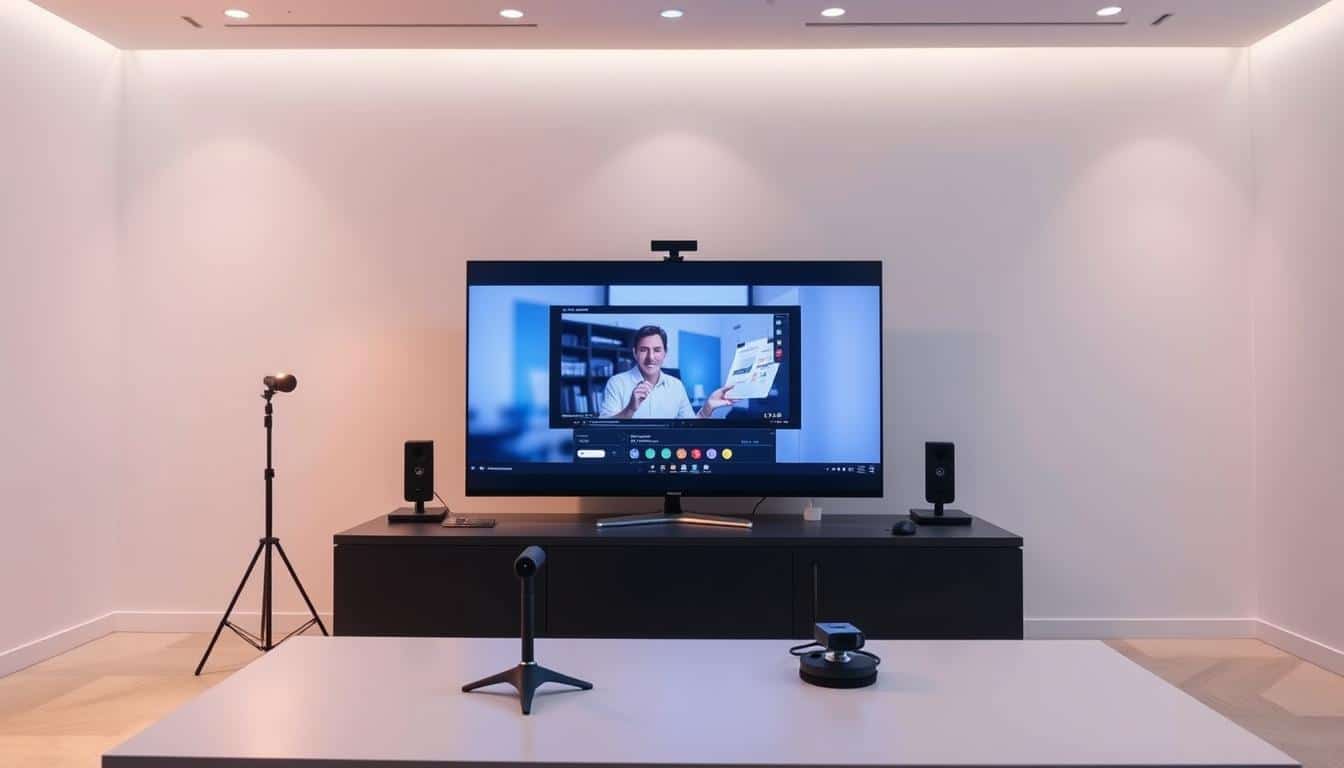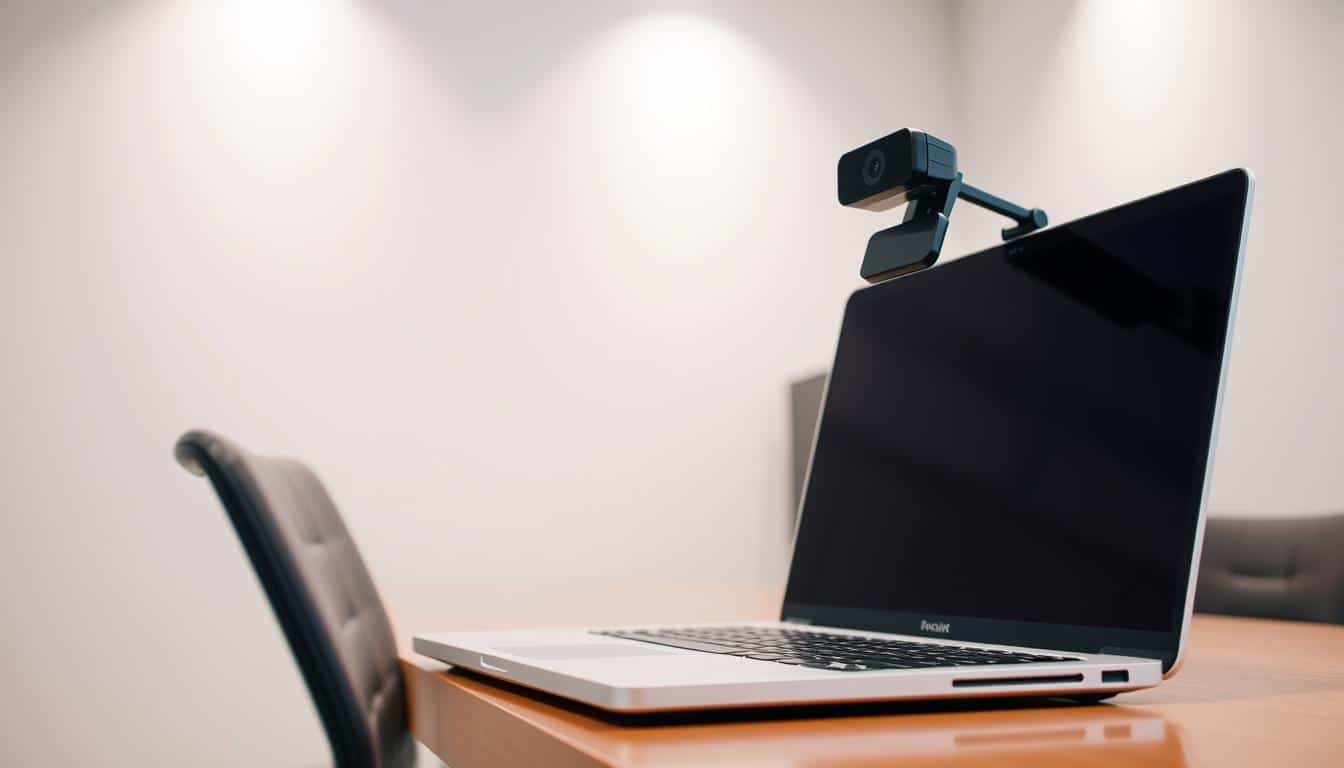Anúncios
Choosing the right virtual meeting backdrop boosts your online look and keeps people involved. It makes you look more professional and helps conversations flow better. Using expert tips, you can make a space that’s great for talking and sharing ideas.
Picking a backdrop means thinking about colors, setup, and style. You need to stand out, so contrast is key. If you’re light-haired or wearing light colors, skip light backdrops. Go for simple designs to keep things clear. This makes sure you’re taken seriously and keeps things professional, making your backdrop choice really stand out.
Anúncios
The Importance of a Professional Virtual Meeting Backdrop
A professional backdrop is key in virtual meetings. It’s not just a visual element. It shows how serious you are. Today’s digital world places high value on a well-chosen background. It sends a message of dedication to the meeting’s success.
Creating a Positive First Impression
First impressions in virtual meetings are vital. A tidy background shows you’re ready and pay attention to details. People trust you more when they see an organized setting.
Anúncios
A messy background can cause others to think less of you. So, a clean, professional backdrop is crucial. Opt for light greys or neutral colors to maintain professionalism. Avoid loud reds that might take away from what you’re saying.
Establishing Credibility in Online Meetings
Your visual presentation online affects your credibility. A professional backdrop shows your brand and the value of your ideas. Simple backgrounds help emphasize your message.
A green screen helps achieve a professional look. It lets you add chosen elements that match your role. This detail builds trust with others, making your meetings more effective.
Factors to Consider in Backdrop Selection
Choosing the right backdrop is key to boosting how effective virtual meetings are. It helps you look more polished and professional. The backdrop you pick can really change how people see your professionalism and their interest level.
Purpose of the Meeting
Think about why you’re meeting when picking a backdrop. For laid-back team chats, a simple and easy-going background is enough. This keeps the vibe relaxed.
But, for serious talks or meetings with clients, you need a fancier backdrop. Professional-looking wallpaper or solid, quiet colors like navy or light gray are good picks. Picking a backdrop that matches the meeting’s goal can really support a professional vibe and set the right mood.
Matching Your Background to Your Role
It’s important to choose a background that fits your professional image. A clean and organized setting helps you look like an expert. Using calm colors and good lighting makes it easy for people to focus on what you say. By carefully choosing your background, you make a strong impression in online meetings.
Virtual Meeting Backdrop Selection: Color Palette Choices
Choosing the right color palette for your backdrop is key. It affects how people see you in virtual meetings. Colors can make discussions more engaging. Warm, soft colors help create a professional, calm setting. Picking the right colors improves the experience and makes meetings better.
Understanding Color Psychology
Backdrops’ colors change the mood and how people see things. Neutral colors like soft greys and light whites work best in virtual spaces. They let natural light make things look better. Your decor should match to keep a unified look. Try using high-contrast colors, like dark blue on light yellow, for clearness. These choices help everyone see better and follow accessibility rules.
The Impact of Light on Color Visibility
Lighting’s effect on your backdrop is crucial. Good lighting makes sure your colors look right and send the right message. Choose a backdrop that makes you look good under any light. Using patterns or textures can make your brand stand out. Just make sure it’s always clear to see. A contrast ratio of 4.5:1 is good for easy reading. Adobe Color’s Contrast Checker is a great tool for making sure your colors work well for everyone.
Physical Setup for an Effective Backdrop
A good virtual meeting backdrop is all about the setup. Picking the right spot is key to looking professional and engaging on video calls. By following smart backdrop location tips, your presentation will really stand out.
Choosing the Right Location
Pick a backdrop that looks good and doesn’t distract. Neutral colors like cream, light blue, and light grey are best. They keep the focus on you and make the setting feel calm. Stay away from loud patterns and bright colors like orange, yellow, and red. They can distract from what you’re saying.
- Position the camera at eye level or slightly above.
- Select furniture arrangements conducive to communication, such as U-shape or hollow square setups.
- Ensure seating promotes participant engagement and visibility.
Lighting Techniques for a Professional Look
Good lighting is key for looking your best on camera. Use different lighting techniques for video, like three-point lighting, and adjustable lights. An LED ring light can also help you look great.
- Avoid backlighting to eliminate unflattering shadows.
- Utilize natural light where possible to enhance the backdrop’s appearance.
- Incorporate sound-absorbing materials to improve acoustics during calls.
For a sleek look, use a 107″ roll of seamless photo paper from Savage Universal. A well-picked backdrop lifts your professionalism. It makes virtual meetings more productive and impressive.
Virtual Backgrounds vs. Reality: When to Use Each
Knowing when to use virtual or real backgrounds can really improve how you connect with others. Virtual backgrounds have their special uses. They make adapting to different situations easy. Knowing when to use each kind can help you pick the right setting for your needs.
Scenarios Ideal for Virtual Backgrounds
Virtual backgrounds shine where looking professional and stylish is key. They are great for:
- Client meetings, where distractions should be minimized to maintain focus.
- Formal presentations that require a polished appearance and a neutral environment.
- Social or casual events, like themed parties or virtual gatherings, where fun and personality can be added.
Virtual backgrounds let you blur things or use clear, high-quality stock pictures. You can personalize with your own images. But make sure they’re clear to avoid messing up the look.
Times When a Reality Background is Appropriate
Choosing a real background depends on your situation and who you’re talking to. A neat, real setting is preferred for:
- Internal team discussions, where a sense of comfort and familiarity is beneficial.
- Interviews or formal reviews that aim to establish credibility and trust.
- Professional settings where a real, tidy environment reflects your seriousness.
The choice between virtual and real backgrounds depends on the situation. Picking the right backdrop can really affect how people see and engage with you.
Creating a Well-Designed Background Wall
A well-designed background wall can make virtual meetings look more professional. It’s all about choosing simple artwork and keeping decorations minimal. This approach creates a welcoming space that’s not too busy.
Adding minimalistic shelves and personal touches can really change your space. And it does this without making it too much for viewers.
Simple Artwork and Minimalistic Shelving
Going for a clean look? Pick simple artwork and shelves. Warm, neutral colors like soft greys and light whites work great. They make natural light look better.
Choose art that’s interesting but not too loud. It should catch the eye, not distract. Place your desk so the backdrop is focused but the wall doesn’t seem too empty.
Incorporating Personal Touches Without Distraction
Adding personal items like bookshelves or small branding signs can bring out your personality. But it should still look professional. Choose decorations that mean something to you and match your work vibe.
Keep things balanced. Stay away from shiny or very bright colors that could distract. You want people to focus on you, not your background.
DIY Tips for Customizing Your Virtual Backdrop
Making your virtual backdrop your own lets you show off your style and look professional on video calls. You can create a background that’s both welcoming and effective with the right stuff and some creative ideas. Here’s how to make a virtual backdrop that’s both personal and engaging.
Materials and Design Ideas for a Unique Look
Think about using a green screen from poster board or fabric for your DIY backdrop. It’s cheap and can change for different scenes. Or, make a gallery wall with art, photos, or kids’ drawings. This adds a personal and warm touch.
Try styling shelves with books, ceramics, and photos too. Use books to lift objects up and mix heights for an interesting look. And why not try temporary wallpaper or vibrant paint colors, like blue or coral? These can make your backdrop pop.
Nature themes in virtual backgrounds mix professionalism with calm vibes, fitting for many meetings. Custom designs work great on platforms like Zoom, avoiding pixelation and keeping your backdrop sharp.
Lighting Considerations for Your DIY Setup
Good lighting is key for video calls and showing off your backdrop. Mix natural and artificial light to look great on camera. Put a soft light source behind your camera to light up your face and keep your backdrop clear.
Sticking with a style or switching between a few keeps your look consistent and professional. Mixing different themes, like brand elements and nature scenes, keeps things interesting without losing impact.
Tips for Avoiding Common Backdrop Mistakes
Choosing the right virtual backdrop is essential for a professional look in online meetings. Thoughtful decisions about your background can avoid distractions. Managing visual noise helps keep the focus on you. Here are key strategies for a distraction-free environment.
Handling Visual Noise in Your Background
To communicate effectively, manage visual noise by picking a simple backdrop. Here are some tips:
- Avoid backgrounds with too much detail or busy patterns.
- Choose non-reflective, matte materials to reduce glare and distractions.
- Opt for subtle gradients or simple designs that don’t overwhelm the viewer.
- Avoid using lots of text in the background, as it can shift focus from you.
- Use elements like plants or simple artwork to make your backdrop personal but tidy.
Avoiding Distracting Elements
Your backdrop should support, not distract from, your presentation. Follow these tips for a clear background:
- Keep the background tidy and free of clutter for a professional look.
- Choose neutral wall colors like creams or beiges for professionalism.
- Use a clean, well-furnished room to boost trustworthiness.
- Prefer natural light, which is warmer and more inviting than artificial light.
- If needed, use high-quality virtual backgrounds that avoid distractions and look good.
Incorporating Brand Identity Subtly
Designing a virtual meeting backdrop is not just about looking good. It helps show off your brand identity in online meetings. Adding subtle brand details to your backdrop can make your brand seem more professional. It makes sure your brand’s values and spirit are well represented.
Using Colors and Logos in Your Backdrop
Choosing the right colors is key. Colors that match your brand help keep a consistent look. Adding your logo subtly, but in key spots, makes your brand memorable without getting in the way. Using high-quality images from places like Unsplash or Envato Elements alongside your logo shows off your brand’s professional side.
Ensuring Authentic Representation of Your Brand
Your backdrop should truly reflect what your brand stands for. Avoid too casual images that could lower how professional you seem. Make sure design elements and text match your brand’s tone. You might use a wall of logos as a central piece. This doesn’t just make the backdrop look better but also builds connections. Through this shared brand experience, it draws people in during online meetings.

Conclusion
A professional virtual backdrop is key when you want to look good online. Helpful tips can improve how you talk during video chats. Choose the right backdrop, like a nature scene or a bookshelf, to look your best online.
Studies show a well-chosen backdrop cuts down on video chat tiredness. It makes meetings better. Nature backdrops help folks focus by cutting down distractions found at home. Picking the right background shows you’re trustworthy and skilled, leaving a great impression.
Having a nice virtual meeting space means better talks and shows you’re serious about your work. Use these ideas to overcome online meeting problems. Make each virtual meeting count and unforgettable.



